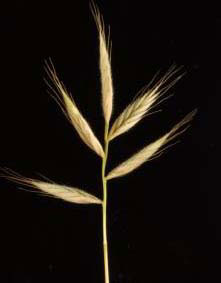- Brachypodium distachyon
Taxobox
name = "Brachpodium distachyon"

regnum =Plant ae
divisio =Magnoliophyta
classis =Liliopsida
ordo =Poales
familia =Poaceae
subfamilia =Pooideae
genus = "Brachypodium "
species = "B. distachyon"
binomial = "Brachypodium distachyon"
binomial_authority = (L.) P.Beauv."Brachypodium distachyon", commonly called purple false brome, is a grass
species native to southernEurope , northernAfrica and southwesternAsia east toIndia . It is related to the majorcereal grain specieswheat ,barley ,oats ,maize ,rice ,rye ,sorghum , andmillet . It has many qualities that make it an excellentmodel organism forfunctional genomics research in temperategrasses ,cereals , and dedicated biofuel crops such asswitchgrass . These attributes include smallgenome (~300-320 Mbp)diploid accessions, a series ofpolyploid accessions, a small physical stature, self-fertility, a short lifecycle, simple growth requirements, and an efficient transformation system.Model organism
Although "Brachypodium distachyon" has little or no direct
agricultural significance, it has several advantages as an experimentalmodel organism for understanding the genetic, cellular andmolecular biology of temperategrasses . The relatively small size of itsgenome makes it useful for genetic mapping andsequencing . At about 300-320 millionbase pairs and with fivechromosome s, it has a small genome for a grass species. Brachypodium distachyon's small size and rapid life cycle are also advantages. For early-flowering accessions it takes about three weeks from germination to flower. The small size of some accessions makes it convenient for cultivation in a small space. As aweed it grows easily without specialized growing conditions."Brachypodium" is emerging as a powerful model with a growing research community. The International Brachypodium Initiative (IBI) held its first genomics meeting and workshop at the PAG XIV conference in
San Diego, California in January 2006. The goal of the IBI is to promote the development of B. distachyon as a model system and will develop and distribute genomic, genetic, andbioinformatics resources such as referencegenotypes , BAC libraries, genetic markers, mapping populations, and a genome sequence database. Besides researchers already working with B. distachyon, other plant research communities will benefit from the availability of these resources.References
*P. Olsen, I. Lenk, C.S. Jensen, K. Petersen, C.H. Andersen, T. Didion, K.K. Nielsen. Analysis of two heterologous flowering genes in Brachypodium distachyon demonstrates its potential as a grass model plant. "Plant Science". In Press.
*Robert Hasterok, Agnieszka Marasek, Iain S. Donnison, Ian Armstead, Ann Thomas, Ian P. King, Elzbieta Wolny, Dominika Idziak, John Draper, and Glyn Jenkins. Alignment of the genomes of Brachypodium distachyon and temperate cereals and grasses using BAC landing with fluorescent in situ hybridization. Genetics: Published Articles Ahead of Print, published on February 19, 2006 as 10.1534/genetics.105.049726.
*John P. Vogel, David F. Garvin, Oymon M. Leong, Daniel M. Hayden. Agrobacterium-mediated transformation and inbred line development in the model grass Brachypodium distachyon. "Plant Cell, Tissue and Organ Culture". 11 January, 2006.
*Christiansen P, Andersen CH, Didion T, Folling M, Nielsen KK. A rapid and efficient transformation protocol for the grass Brachypodium distachyon. "Plant Cell Rep". 2005 Mar 23(10-11): 751-8. Epub 2004 Oct 19.
*Kjeld C. Engvild. Mutagenesis of the Model Grass Brachypodium distachyon with Sodium Azide. Riso National Laboratory, March 2005.
*Hasterok R, Draper J, Jenkins G. (2004). Laying the cytotaxonomic foundations of a new model grass, Brachypodium distachyon (L.) Beauv. "Chromosome Res". 12 (4): 397-403.
*Routledge, APM, Shelley, G, Smith, JV, Talbot, NJ, Draper, J & Mur, LAJ (2004). Magnaporthe grisea interactions with the model grass Brachypodium distachyon closely resemble those with rice (Oryza sativa). "Molecular Plant Pathology" 5 (4): 253-265.
*Mur LAJ, XU R, Casson SA, Stoddart WM, Routledge APM AND Draper J. Characterization of a proteinase inhibitor from Brachypodium distachyon suggests the conservation of defence signalling pathways between dicotyledonous plants and grasses. "Molecular Plant Pathology" 5 (4): 267-280.
*Draper J, Mur LA, Jenkins G, Ghosh-Biswas GC, Bablak P, Hasterok R, Routledge AP. (2001). Brachypodium distachyon. A new model system for functional genomics in grasses. "Plant Physiol". 127 (4): 1539-55.
*Catalán P and Olmstead RG. (2000). Phylogenetic reconstruction of the genus Brachypodium P. Beauv. (Poaceae) from combined sequences of chloroplast ndhF gene and nuclear ITS. "Plant Systematics and Evolution" 220: 1-19.
*Catalan P, Shi Y, Armstrong L., Draper J, Stace CA. (1995). Molecular phylogeny of the grass genus Brachypodium p-beauv based on RFLP and RAPD analysis. "Botanical Journal of the Linnean Society" 117: 263-280.
*Bablak P, Draper J, Davey MR., Lynch, PT. (1995). Plant regeneration and micropropagation of Brachypodium distachyon. "Plant Cell and organ culture" 97: 107.
*Hsiao C, Chatterton NJ, Asay KH, Jensen KB. (1994). Phylogenetic relationships of 10 grass species: an assessment of phylogenetic utility of the internal transcribed spacer region in nuclear ribosomal DNA in monocots. "Genome" 37 (1): 112-20.
*Shi Y, Draper J, & Stace C. (1993). Ribosomal DNA variation and its phylogenetic implication in the genus Brachypodium (Poaceae). "Plant Systematics and Evolution" 188: 125-138.External links
* [http://www.brachypodium.org/ www.brachypodium.org] - The "Brachypodium distachyon" Information Resource
* [http://www.ars-grin.gov/cgi-bin/npgs/html/taxon.pl?7597 Germplasm Resources Information Network: "Brachypodium distachyon"]
* [http://www.brachypodium.org/IBI/ THE INTERNATIONAL BRACHYPODIUM INITIATIVE]
* [http://www.intl-pag.org/14/14-brac.html Brachypodium distachyon Genomics Workshop]
* [http://www.brachypodium.org/Bd_Accessions.html Inbred Brachypodium distachyon Lines and Genetic Resources]
Wikimedia Foundation. 2010.
